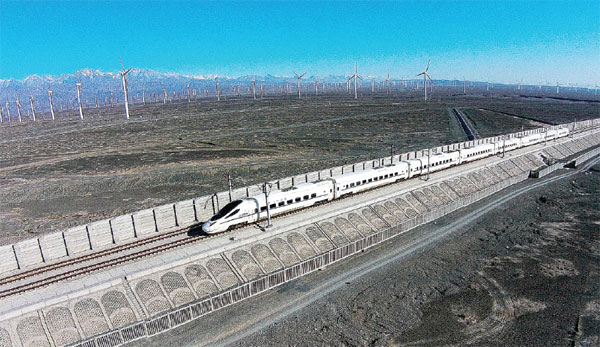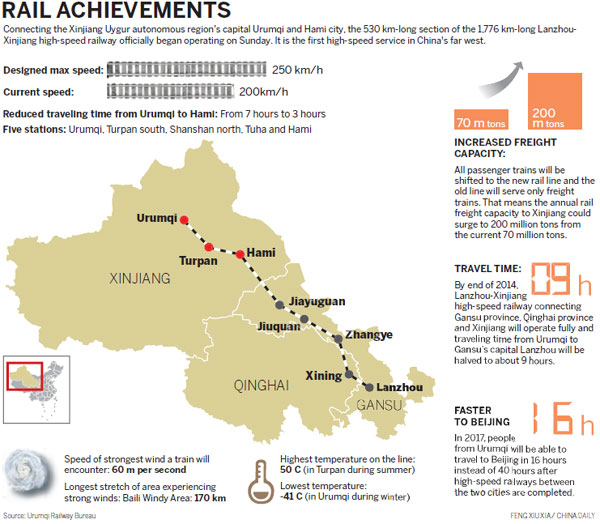Xinjiang shifts into top gear with high-speed rail
Updated: 2014-11-28 07:59
By Cui Jia in Urumqi(China Daily USA)
|
|||||||||
|
The new high-speed train passes the Dabancheng wind power station on its way from Hami to Urumqi on Sunday. Connecting the Xinjiang Uygur autonomous region's capital, Urumqi, and Hami, the 530-km-long section of the 1,776-km-long Lanzhou-Xinjiang high-speed railway officially began operating on Sunday. An attendant checks a passenger's ticket on the high-speed train from Hami to Urumqi on Sunday. Jiang Wenyao / Xinhua |
 |
| Helping to improve lives |
| Growth on track |
| Expanding network |
He was trapped in the train for 54 hours during the journey that covered nearly 2,000 km. "I looked out at the seemingly endless Gobi Desert and said to myself 'Xinjiang is just too far away'.
"But Xinjiang finally has a high-speed railway, which has brought us closer to the rest of the country and, most important, to Beijing."
Born in Lanzhou, the 52-year-old has since settled in Urumqi.
On Nov 6, when tickets for the new service between Urumqi and Hami city on the Lanzhou-Xinjiang high-speed railway were being sold for the first time, Sun excitedly checked the timetable at the Urumqi South railway station.
The 530 km service between Urumqi and Hami started on Sunday. It is the first high-speed service in China's far west and halves the seven-hour traveling time. First-class seats cost 196 yuan each and second-class seats 163.5 yuan each.
But Sun really wanted to find out when the whole 1,776-km Lanzhou-Xinjiang high-speed railway, which also passed through Qinghai province, would be in full operation.
"I was told by railway staff that it will take only nine hours to Lanzhou from Urumqi once the whole high-speed railway is running at the end of this year," he said.
"It's just unbelievable, compared with that 54 hour-journey I first took," he said, while sending a text message to his wife to tell her the good news.
"For many people, Xinjiang seems like a faraway and mysterious region at the western end of the country. Some still believe that we ride camels to work," Sun said.
"The long distance between the region and the rest of China has created communication problems and even misunderstandings."
"For visitors, the cost of traveling to Xinjiang, which accounts for about one-sixth of China's land area and boasts rich tourist resources, is their main concern. Due to the long distances involved, plane tickets are expensive and train journeys can be very long," said Hui Xinru, manager of the Xinjiang Kanghui Daziran international travel agency.
By 2017, train passengers from Beijing will be able to reach Urumqi in 16 hours instead of the current 40 hours after all high-speed rail links between the two cities are completed.
Once the Lanzhou-Xinjiang high-speed railway rolls out, the region expects more than 40 percent of its tourists to arrive on the new trains, which will help drive the development of regional tourism, said Ma Rui, deputy inspector of Xinjiang's tourism bureau.
The high-speed rail will shorten the traveling time between Xinjiang and other provinces, with people having more time to experience Xinjiang rather than spend most of the time on the road, Ma said.
"They are welcome to stay with the locals and have a better understanding of Xinjiang people."
Sun himself is thinking about taking a day trip to Turpan, which is one of the stops on the high-speed railway and takes less than an hour to get to from Urumqi.
Turpan is famous for its grape plantations, and local Uygurs still use traditional methods to make raisins. It is also known for its ancient irrigation system made up of wells linked by underground canals that channel mountain runoff to reduce the evaporation of water resources in the hot and arid area.
Tourism is one of the prefecture's pillar industries, and Turpan has received 3 million visitors so far this year.
The new railway is expected to draw 30 percent more tourists to Turpan. The local government has decided to offer discounts on tourist sites for visitors like Sun who take the high-speed rail, said Chen Shuguo, director of the prefecture's tourism bureau.
"A 'high-speed rail' fever has hit Turpan residents. We have been constantly thinking about the possibilities brought by it," Chen said.
Ma from the regional tourism bureau said the regional government will take advantage of high-speed rail to make tourism income account for 10 percent of the region's annual GDP, from the current 8 percent.
The surge in tourism will boost labor-intensive industries such as the services and handicraft sectors and generate more jobs.

 Daredevil dancer conquers mountain
Daredevil dancer conquers mountain
 Chinese float gives joy at Macy's parade
Chinese float gives joy at Macy's parade
 Calm comes to troubled Ferguson
Calm comes to troubled Ferguson
 6 things you should know about Black Friday
6 things you should know about Black Friday
 Visa change may boost tourism to the US
Visa change may boost tourism to the US
 China's celebrity painters
China's celebrity painters
 Beauty of Beijing float making debut in Macy's parade
Beauty of Beijing float making debut in Macy's parade
 Rescue dogs show skills in NW China
Rescue dogs show skills in NW China
Most Viewed
Editor's Picks

|

|

|

|

|

|
Today's Top News
China, US fight terror on the Internet
How to give is focus of philanthropy forum
China, US diverge on approaches to nuclear energy
China's local govt debt in spotlight
Macy's looks to appeal to more Chinese customers
Clearer view of Africa called for
Cupertino, California council is majority Asian
BMO Global Asset Management Launches ETFs in Hong Kong
US Weekly

|

|










